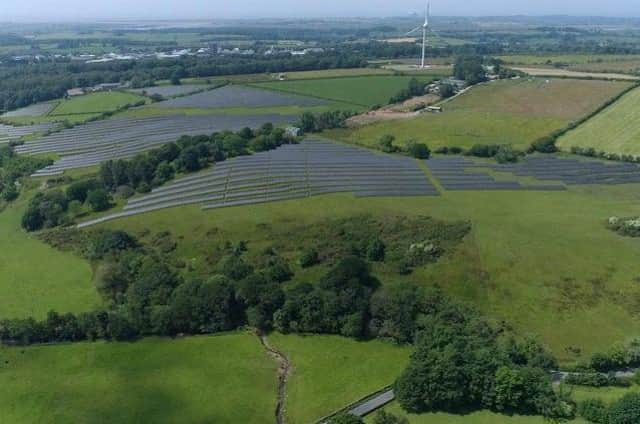Large-scale solar farm plans by Lancaster University hit by residents' concerns


Lancaster University submitted plans to the city council earlier this year for a large solar farm on land to the north of Forrest Hills in Hazelrigg Lane.
It followed the university declaring a Climate Emergency in November 2020. It is aiming to become carbon neutral for energy emissions by 2030, and for all its emissions by 2035.
Advertisement
Hide AdAdvertisement
Hide AdThe declaration represents a strengthening of the university’s commitments to sustainability, having already reduced its energy related carbon emissions by 50 per cent over the past 10 years.
As part of a bid to significantly reduce carbon emissions, the university drew up plans for a solar photovoltaic farm near its campus.
Solar photovoltaic panels capture the energy of the sun and turn it into electricity without the need for fossil fuels.
The proposed development would be capable of generating approximately 16.5MW, comprising around 36,000 solar panels providing 60 per cent of the university’s current annual electrical consumption.
Advertisement
Hide AdAdvertisement
Hide AdEach photovoltaic panel would be mounted above the ground with a gap of 3m between each row of panels to allow for planting and wildlife.
We reported in July how the university was seeking public opinion on the development.
A total of 166 responses were recorded, with 74 per cent in support of the proposals.
However, a wide range of issues were raised by respondents, ranging from general concerns to specific comments on aspects of the design.
Advertisement
Hide AdAdvertisement
Hide AdThe most frequent suggestions for improvement centred around biodiversity, visual impact, and the provision of panels on existing buildings at the university first.
Others suggested alternative renewable energy solutions such as placing solar panels on buildings and structures within the university campus and installing more wind turbines.
And residents have also registered their concerns on the city council planning portal that the 21.44 hectare development will have a significant visual impact on the area.
Residents' concerns include the distance of the proposed farm from some of their properties, as well as the impact it will have visually and on the landscape.
Advertisement
Hide AdAdvertisement
Hide Ad"It is not in keeping with its character or with its surroundings in terms of scale or character," one resident said in a statement to the city council. "We would argue it has an adverse effect on the appearance of the landscape."
Other concerns include the impact on wildlife and agriculture, noise, security and community benefit of the scheme.
"[There would be a] significant loss of residential amenity for the many who enjoy, and expect, a rural outlook," a resident said.
Quernmore Parish Council has also registered an objection to the proposals saying: "Although not in the parish it adjoins it and the solar panels will be visible from the high ground to the east and south of the site.
Advertisement
Hide AdAdvertisement
Hide Ad"The parish council is concerned at the level of glint and glare from the panels and the effect it will have on adjacent properties and local residents.
"This is a large development completely out of place in and adjacent to the Forest of Bowland AONB. The development is seen as detrimental to the landscape, visual amenity and biodiversity. Concern was also expressed about surface water run off and potential flooding downstream of the site."
Consultation with stakeholders also brought up issues, including the landscape and visual impact, highways, flood risk and drainage, glint and glare, and noise and vibration.
After a meeting with the Lune River Trust, the university amended its plans to remove some panels after the trust raised concerns associated with placing panels in an area of Flood Risk Zone where the trust is considering the development of swales - channels built to carry stormwater and reduce pollutants.
Advertisement
Hide AdAdvertisement
Hide AdThe university has also met with Scotforth Parish Council to discuss the proposed development, with issues raised including the scope of the landscape and visual assessment, grazing of the site, source of materials, construction traffic and implementation of landscaping.
In their submission to the council, they said: "We believe that the solar farm is a necessary contribution to the measures to address the climate emergency, that the university has taken reasonable steps to minimise any adverse impact and has taken the opportunity to provide welcome and appropriate community benefits.
"Whilst we have no objections to this planning application, we wish to see what additional measures Lancaster University have in mind to close its carbon and energy deficit, in order to be assured that they do not have a detrimental impact on the local community."